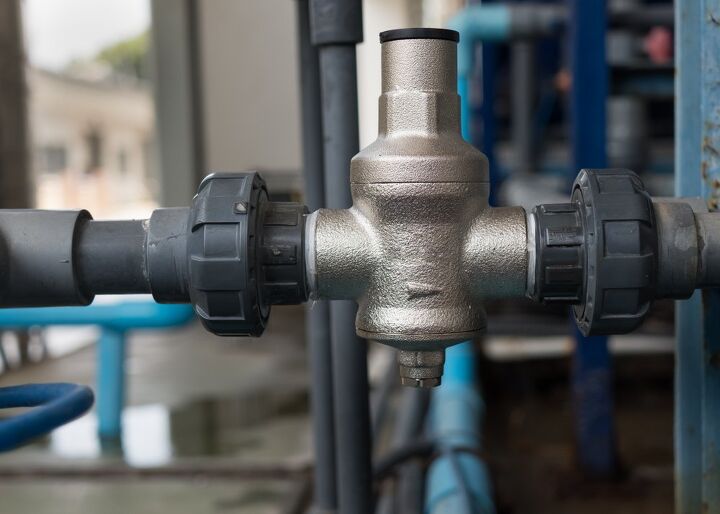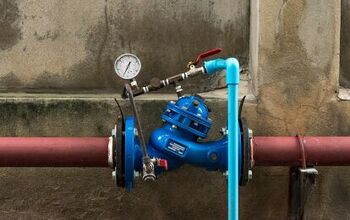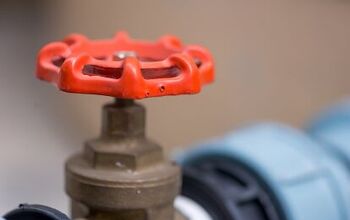Pressure Reducing Valve Installation Cost

Water pressure is one of those things that we tend not to notice until it becomes a problem. By then, the excess force may have already done real damage to your home. Managing water pressure is important and you can do that with the help of a pressure reducing valve.
A pressure reducing or pressure regulator valve is designed to keep your water pressure at a safe level. It’s an important fixture to have installed, but there’s a chance you don’t have one yet. You may want to get started on changing that.
The average pressure-reducing valve installation cost is $452 including the unit, materials, and labor. Homeowners pay an average of $40 per hour on labor for pressure-reducing valve installation, and it takes 2 ½ hours. You can spend $100 extra in material costs if the professional doesn’t include hardware in their base cost.
Installing a pressure reducing valve can turn out to be a huge difference-maker for your home. Learn more about how the pressure reducing valve, the installation, and all the other related expenses will cost by reading on.
Average Cost to Install a Pressure Reducing Valve
| Expense | Price Range |
| Pressure Reducing Valve | $65 to $700 |
| Labor Costs | $16 to $27 Per Hour |
| Additional Materials | $40 to $100 |
Cost of a Pressure Reducing Valve
| Pressure Reducing Valve Type | Price |
| Low-End Option | $65 |
| Mid-Range Option | $400 |
| High-End Option | $700 |
As we dive deep into this installation cost guide, we can start by talking about the valves first. You can see a large variance in terms of how much pressure reducing valves cost. Some are available for as low as $65 while others cost up to $700.
You may actually see some pressure regulator valves that cost more than $700. There are even options currently on sale for thousands of dollars.
Do note however that those super expensive items are commercial valves. You don’t necessarily need a commercial valve to manage the water pressure for your home. That is not the kind of expense you should be taking on.
How to Choose a Pressure Reducing Valve
Given the sheer number of options available, finding the right pressure regulator valve can be tricky. You may have a tough time even differentiating the available options from one another.
To make your search easier, we’ve highlighted the factors that matter most when choosing a pressure reducing valve. Keep them in mind as you make a decision regarding which one to buy.
Material Composition
The most important factor to consider when shopping for a pressure reducing valve is its material composition. Pressure regulator valves can be made from aluminum, brass, bronze, iron, and even synthetic materials. If you’re looking for something affordable, your best bet is to look for valves fashioned from synthetic materials. The ones made from aluminum are also on the cheaper side as well.
Obviously, there’s a catch that comes with purchasing the less expensive pressure regulator valves. The main issue with those valves is that they typically don’t last very long. They often give out years before the other types of valves do.
Valves made from aluminum and/or synthetic materials also get damaged faster. Exposing those valves to high pressure for a prolonged period of time could lead to very early replacement. On the opposite end of the cost spectrum, you have the brass and bronze pressure regulator valves. These are the items that often sell for hundreds of dollars.
In exchange for your willingness to invest, you’re getting a valve that you can count on for years to come. They also withstand high water pressure better. You can wind up spending less by buying one high-quality valve instead of multiple cheap ones. It’s up to you to decide which option makes more sense for your plumbing.
Size
Unlike the material composition, the size of the valve doesn’t have a significant impact on pricing. That said, you should still pay close attention to that characteristic of the valve.
Make sure you inspect the spot where you intend to install the valve beforehand. Measure the pipe to get the right size you need. You don’t want to make multiple purchases simply because you weren’t diligent enough the first time.
Connection Type
Connection type is similar to size in terms of maintenance. You mainly need to check it to ensure the valve will be compatible with your plumbing. Beyond that, the connection type is not going to make that much of a difference.
Additional Features
Some pressure reducing valves do more than just manage the water pressure for your home’s plumbing system. They may also be loaded with certain features which enable them to be more helpful to your home.
For instance, some pressure reducing valves include strainers. The strainers are responsible for filtering out any debris coming from the external water supply. Those strainers can also be removed and cleaned to ensure the proper operation of the valve.
You can also find pressure regulator valves that have built-in pressure gauges. We love that additional feature because it makes monitoring your plumbing system significantly easier.
Homeowners should know that the additional features will lead to the valves becoming more expensive. Their inclusion could lead to a price increase of $20 or even $100 in some cases. Whether or not the extra dollars are worth it for the additional features will be your call.
Why Do You Need a Pressure Reducing Valve?
Is purchasing a pressure reducing valve truly necessary? It’s a fair question to ask considering how expensive one can be. In this section, we’ll discuss the different ways pressure reducing valves can help homeowners. See if the upcoming benefits are ones you want for your home.
Leak Prevention
High water pressure is damaging. Continuous exposure to it is not going to be good for any of the fixtures in your plumbing system. The pipes in particular are vulnerable to the kind of destructive force that high water pressure produces.
If that kind of pressure persists, the pipes will inevitably spring a leak. They may be small leaks at first, but they can get bigger if you aren’t able to address them right away.
Multiple pipes in your plumbing could wind up getting damaged by the high water pressure. You can stop that from happening by installing a pressure reducing valve.
Fixture Protection
Pipes are not the only elements of your home that may sustain damage from high water pressure. Certain fixtures inside your home are also at risk. They include your water heater, your toilet, and your washing machine, just to name a few appliances.
Replacing those appliances is also just a temporary fix. You have to get to the root of the problem and that may involve installing a pressure regulator valve.
Water Conservation
One more reason why you should consider installing a pressure reducing valve is water conservation. High water pressure is unnecessary in most households.
The increased pressure may actually be leading to a precious resource being wasted. Regulate the pressure better using the right valve and stop wasting water. Along with conserving a valuable resource, you may also be able to save money by installing that valve.
Labor Costs for Installing a Pressure Reducing Valve
| Plumber Experience Level | Hourly Rate |
| Entry-Level Plumber | $16 |
| Early-Career Plumber | $18.50 |
| Mid-Career Plumber | $23 |
| Highly Experienced Plumber | $27 |
Different factors will affect how much you’ll have to pay for the professional installation of your pressure reducing valve. We have outlined what those factors are below.
Experience Level
Experience level matters if you’re hiring a plumber to handle the installation of the pressure reducing valve. It matters for two specific reasons.
First off, you obviously want to hire a plumber with the requisite experience to handle the installation. Most plumbers who have at least a year of experience are familiar with pressure reducing valves.
If you’re planning to hire a relatively inexperienced installer, ask if they’ve worked with pressure regulator valves first. It can be risky to hire someone with no experience, but the savings can be appealing.
The hourly rate for an entry-level plumber is $16. That’s $11 lower than the hourly rate for a highly experienced plumber. Depending on how long the installation takes, you could save a lot of money by taking that chance.
Hourly Rate or Flat Fee
Not all plumbers work at an hourly rate. Some will also take on the job for a pre-negotiated fee.
Installing a pressure reducing valve will probably take around two to three hours. If we’re going by the cheapest hourly rates for plumbers, that means you’ll likely pay $32 to $48 for the installation. You can use those numbers as reference points when negotiating a flat fee.
Materials Supplied by the Plumber
The pressure reducing valve is not the only item required to complete the installation. Some additional connectors and fittings may also be needed for the job. The plumber may also have to use some special mounting hardware to properly secure the valve.
Asking the plumber to supply materials will tack on some extra dollars to the final bill. For a few fittings and connectors, the plumber may charge you an extra $40. If they have to supply a lot of hardware, you’re looking at an additional charge of $100.
Additional Services
The plumber you hired may not be able to install the pressure reducing valve right away. Before they can get to that, they may have to perform other services first.
Removing an existing pressure reducing valve is going to take some time. The same goes for inspecting the pipes and seeing where the new valve should be installed. You may have to pay for an extra hour because of those supplemental tasks.
Notably, those supplemental tasks are actually the easier ones for plumbers. If you haven’t been paying attention to your plumbing system, more labor-intensive tasks may be required before the valve can be installed.
The plumber may notice that some of your pipes are already leaking. They will have to address those before they can proceed to installing the valve. It’s possible that some pipes may have to be replaced as well, thus causing the job to take longer.
Although installing a pressure regulator valve is a relatively minor plumbing job, it still cannot be carried out without prior clearance. Complying with those guidelines could also add more expenses to your bill.
In some cases, a permit may be required before the pressure reducing valve can be installed. Your plumber can secure that permit from the local government, but that could make your final bill larger as well.
Related Questions
How Long Will a Pressure Reducing Valve Remain in Working Condition?
Although pressure reducing valves are routinely exposed to an incredible amount of force, they can still hold up for a while. A quality pressure reducing valve should remain in working condition for at least 10 years.Homeowners who splurged on their purchases by getting the brass or bronze valves can expect them to last longer. Those more expensive valves often last up to 15 years. Keep the pressure regulator valve well-maintained and it could last for over 20 years.Of course, those are still just estimated lifetimes for your pressure regulator valves. They could still fail well before then. Watch out for the telltale signs of a malfunctioning valve and save your fixtures from potential damage.You can tell that a valve is struggling when you get random spikes in water pressure. The spikes will often happen after turning a fixture on. The spikes in water pressure will also become more frequent as the valve continues to deteriorate.Loud noises could also be hinting at a damaged valve. With the valve damaged, it may no longer be capable of holding up against the force of the water.
How Do You Adjust the Pressure Regulator Valve?
Adjusting the pressure level for the regulator valve is a simple process. You will only need a wrench to get it done.Start by locating the pressure reducing valve. After finding it, look for its lock nut and start turning that counterclockwise. The lock nut should come loose after a few turns. With the lock nut removed, you can now tweak the adjustment screw. Turning the adjustment screw clockwise will increase the water pressure. Moving it counterclockwise will decrease the water pressure.You can now test the pressure level by turning on a water fixture. Once you’re satisfied with the pressure level, simply put the lock nut back in place.
Related Articles

Gary Evans is passionate about home improvement. He loves finding out how to make improvements in the easiest, most practical, and most affordable ways. Upgrading his home kitchen is one of his ongoing hobbies. Gary is also a long-time content creator and enjoys spending his free time tending to his hydroponic vegetable garden.
More by Gary Evans












![10 Best Scroll Saws for 2022 [Ultimate Reviews & Buyer's Guide]](https://cdn-fastly.upgradedhome.com/media/2023/07/31/9070684/10-best-scroll-saws-for-2022-ultimate-reviews-buyer-s-guide.jpg?size=350x220)
![10 Best Electric Lawn Mowers - [2022 Reviews & Top Rated Models]](https://cdn-fastly.upgradedhome.com/media/2023/07/31/9070486/10-best-electric-lawn-mowers-2022-reviews-top-rated-models.jpg?size=350x220)
![10 Best Cordless Leaf Blowers – [2022 Reviews & Ultimate Guide]](https://cdn-fastly.upgradedhome.com/media/2023/07/31/9070789/10-best-cordless-leaf-blowers-2022-reviews-ultimate-guide.jpg?size=350x220)












